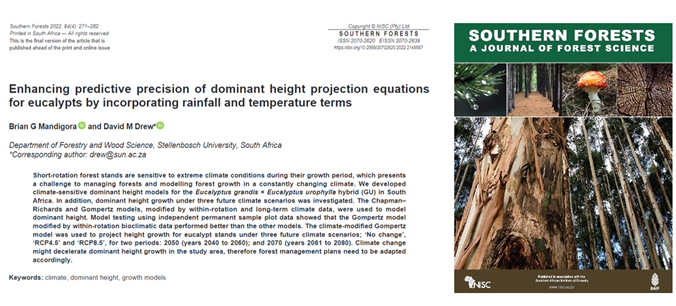
The Hans Merensky Chair in Measuring and Modelling Eucalypt Growth & Wood Formation
Understanding growth in the world's most widely planted hardwoods
A new paper in Southern Forests
Post authored by Dr Letitia Schoeman
Recently Brian Mandigora, a PhD candidate, published his first paper titled “Enhancing predictive precision of dominant height projection equations for eucalypts by incorporating rainfall and temperature terms” in the Southern Forests journal. Well done Brian!

Short-rotation forest stands are sensitive to extreme climate conditions during their growth period, which presents a challenge to managing forests and modelling forest growth in a constantly changing climate. In this paper we developed climate-sensitive dominant height models for the Eucalyptus grandis × Eucalyptus urophylla hybrid (GU) in South Africa. In addition, dominant height growth under three future climate scenarios was investigated. The Chapman–Richards and Gompertz models, modified by within-rotation and long-term climate data, were used to model dominant height. Model testing using independent permanent sample plot data showed that the Gompertz model modified by within-rotation bioclimatic data performed better than the other models. The climate-modified Gompertz model was used to project height growth for eucalypt stands under three future climate scenarios; ‘No change’, ‘RCP4.5’ and ‘RCP8.5’, for two periods: 2050 (years 2040 to 2060); and 2070 (years 2061 to 2080). Climate change might decelerate dominant height growth in the study area, therefore forest management plans need to be adapted accordingly.
Read the full article at Enhancing predictive precision of dominant height projection equations for eucalypts by incorporating rainfall and temperature terms (tandfonline.com).